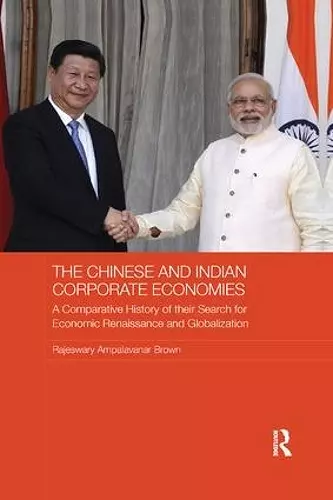The Chinese and Indian Corporate Economies
A Comparative History of their Search for Economic Renaissance and Globalization
Format:Paperback
Publisher:Taylor & Francis Ltd
Published:17th Jan '19
Currently unavailable, and unfortunately no date known when it will be back
This paperback is available in another edition too:
- Hardback£190.00(9781138929883)

This is a compelling analysis of the corporate economies of China and India, which are having a huge impact not just on the international economy, but also in the geopolitical and international strategy sphere as a result of an accelerated globalisation by these two countries, which is unleashing powerful economic challenges to corporate structures, economic institutions and law worldwide. The big question is how after centuries of underdevelopment China and now India are emerging powerfully and pulling ahead of Western European economies. Analysing the role of the state and the adroit use of law, and their impact on the corporate evolution of both China and India, provides greater clarity and insight into why China has evolved as a manufacturing nation utilizing cheap abundant labour while India has not exploited such advantages but instead focused on IT and higher value industries, even abroad as Tata has demonstrated in the motor industry in Europe. Again while Chinese corporations have expanded abroad as an arm of the state into Asia, Middle East, Africa, Europe, Latin America and parts of the southern states of the USA, India has pushed principally into Europe through the efforts of powerful minority capitalists of Parsi and Gujerati background, overcoming technological gaps and differences through acquisitions and absorptions of existing corporations in particular industries, especially in steel, automobiles and textiles. In China, state owned corporations have been dominant. In India, though state owned enterprises have been powerful since 1951, it has been private capitalists with an established stronghold since the colonial period and even under the Socialist period from 1951-1991 who have been the more productive main actors both in India and abroad.
"A richly detailed and accessible comparison of development in China and India. Rajeswary Ampalavanar Brown combines insights of the economist and the business historian, weaving together first-hand knowledge of an impressive field of topics, from farms to financial markets, and from moral economy to corporate branding. Her sophisticated analysis leaves behind clichéd images of Asian business, revealing the complex interplay of global norms and culturally specific practices like waqf trusts and guanxi relations, as well as the interaction between common law and national capitalism, and corporate strategies to emulate and supplant foreign competitors."
Thomas DuBois, Australian National University (ANU), Australia.
"This insightful and ambitious book seeks to explain the contrasting pathways of capitalist transformation in two of the largest economies of the world, India and China, paying attention to the role of the state, legal infrastructure, cultural practices, and resource endowments. An essential reading for economists and historians interested in the 'emergence' of Asia, the book confirms Professor Brown’s reputation as a foremost authority on Asian capitalism."
Tirthankar Roy, Professor of Economic History, London School of Economics and Political Science, UK.
ISBN: 9780367175559
Dimensions: unknown
Weight: 703g
472 pages